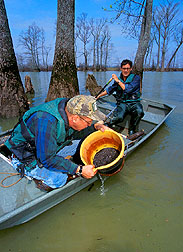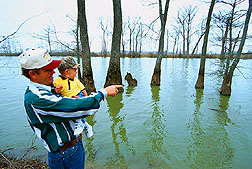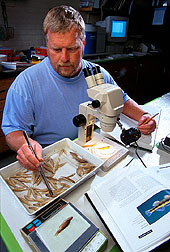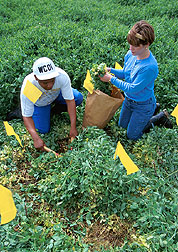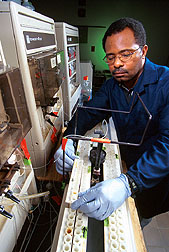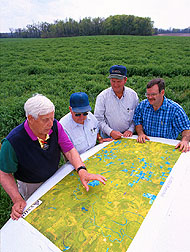Mississippi Delta MSEA
|
|
Grower-assisted research helps curb water pollution.
Floyd Anderson, Jr., has a special present for his young son, Will. It will be perfect for father-son fishing trips.
Anderson, a farmer in the Mississippi Delta region, has a 40-acre oxbow lake stocked with bass and catfish 300 yards behind his house. Thighman Lake is the boy's gift. Anderson is participating in an Agricultural Research Service program to improve water quality in oxbow lakes. By doing so, he has helped preserve Thighman Lake for his youngest son.
"The biggest impairment to fish in oxbow lakes is sediment—not farm chemicals," says ecologist Scott S. Knight, who is with the ARS National Sedimentation Laboratory in Oxford, Mississippi. "That's why we need to find ways to keep the soil in place on farms."
But Thighman is just one example. Visibility in the water of nearby Deep Hollow Lake has improved to a depth of more than 15 inches, increasing the amount of algae, fish, and even turtles.
Change at Thighman is less dramatic, but it's made Anderson excited about the possibility of fishing there.
Anderson, 45, grew up on the family farm—the Anderson Planting Company. He grows soybeans, corn, rice, and sometimes cotton on his 4,300 acres. His lake is part of a large-scale initiative to evaluate how environmentally friendly farming practices can benefit oxbow lakes. Its official title is the Mississippi Delta Management Systems Evaluations Area, or MSEA.
Seventeen farmers cooperate with ARS, the U.S. Geological Survey, Mississippi Water Resources Research Institute, and others who are conducting scientific experiments in the project. Anderson says the project has given him and other Mississippi farmers a lift: It has restored their unfairly tarnished reputations.
|
|
"The public never sees all I do to protect the land," says Anderson. "Why would I make 10 or 12 tilling trips across a field and erode my soil—and pay $6 an acre each time to do it—when 3 or 4 trips will do?"
Delta Farmers Try Cover Crops
The 5-year, multimillion-dollar Mississippi Delta MSEA comprises about 7,320 acres of farmland around three lakes: Thighman, Beasley, and Deep Hollow, in Mississippi's Sunflower and Leflore Counties.
"The project has been an enormous undertaking," says ecologist Charlie Cooper. He heads Oxford's Water Quality and Ecological Processes Research Unit at the sedimentation lab.
"Most farmers are naturally inclined to experiment," he says. "We have to have flexible research and build on what we learn each season."
For example, cover crops like the wheat and rye planted in Deep Hollow's watershed protect the soil from winter's pelting rains but need to be replanted every year. ARS agronomist Seth M. Dabney at Oxford may have an alternative, and he's trying it on Anderson's farm.
|
|
"Balansa clover adds about 75 pounds of crop-feeding nitrogen per acre to the soil every year it's used. It produces lots of seeds, so farmers don't have to replant annually," says Dabney. "And it does well in the Southeast Cotton Belt."
In springtime, the clover's white flowers attract honey bees. After the plants die, they add organic matter to the soil, which can improve crop productivity.
Preserving Farmers' Reputations
"Farming's all I've ever done, and it's all I ever want to do," Anderson says. "To learn that the groundwater was not polluted and we're not leaking chemicals like some people say—that has been worth whatever I've done for the project, just to find out that's not the case."
ARS chemist Sammie Smith, Jr., drilled wells in the watersheds surrounding the three test lakes to monitor for 18 different agricultural chemicals at 5-, 10-, and 15-foot depths.
That's about 100 MSEA wells. Over 3 years, only 5 of more than 600 well samples showed any pesticide traces. Even then, the amounts were usually found shortly after a field application and were well within the limits allowed for drinking water.
Another groundwater concern is nitrate-nitrogen contamination. This is a special risk for infants.
Soil scientist Jonathon D. Schreiber had been checking wells for this potential contaminant and he, too, found the water was safe for drinking.
"We wanted sound science—not sound bites—on farming and the environment," says Frank Gwin, a retired farmer who serves as the MSEA project's liaison between researchers and farmers. "If the news had been bad, we'd have wanted to know. But it seems we have a clean bill of health."
Soil Microbes That Cut Pollution
|
|
Scientists from Stoneville, Mississippi, are exploring how beneficial enzymes, microbes, and algae are increased by conservation practices. These microbes may help remove chemicals and enhance soil.
"We hope to better understand how microbial populations improve water quality by degrading pesticides," says soil scientist Martin A. Locke. He heads the ARS Southern Weed Science Research Unit in Stoneville. "This knowledge is essential for developing management practices that maintain diverse aquatic microbial populations that are effective in pesticide breakdown."
Microbiologist Robert M. Zablotowicz, who is in Locke's unit, teamed with Knight to find that Deep Hollow—with the most conservation practices in use of any of the MSEA watersheds—had the least sediment and the highest algal population of the three lakes. Algae are vital to the lakes' health, forming the basis of the food chain, for starters. But that's not all.
"Certain species of one-celled green algae in the lake can metabolize specific soil-applied herbicides, such as atrazine and fluometuron," says Zablotowicz. "We also found a kind of bacteria called fluorescent pseudomonads. These can also degrade certain herbicides."
The right farming practices can boost the soil's microbial pollution-stoppers.
Soil Quality's Another Key
"Soil quality means many things to many people. The factors we are looking at include increasing organic matter and improving the balance of plant nutrients, like nitrogen and phosphorus, that play a role in soil productivity," says Locke.
Cover crops can improve the soil by enhancing the food supply for living things—insects, spiders, worms, and microbes—that help make the soil porous, says Dabney. He is evaluating tilling methods that won't disturb cover crops but will break up hardened soil.
Some farmers believe reduced tillage and cover crops will open the door to diseases, weeds, and reduced yields. If MSEA demonstrates this doesn't have to happen, more farmers will be willing to try these practices.
"Limited information is available on the effects of reduced tillage and cover crops in cotton production systems," says Locke. "Our initial goals were to characterize the differences in the biological, chemical, and physical soil properties in the Beasley and Deep Hollow watersheds, where different cotton management practices are used."
At Deep Hollow, Dabney is testing gypsum, or calcium sulfate, as a way to help with yields. "People have been using lime for centuries to reduce soil acidity and build up calcium, an essential element for plants," he says. "ARS research at West Lafayette, Indiana, has shown that gypsum lets more rain soak into the soil and reduces erosion."
Keeping Weeds in Check
Differences in soil properties can influence how agricultural chemicals react. Knowledge of those differences and of weed populations in the three watersheds will help determine proper herbicide and fertilizer applications. The information will also allow the use of computer-driven systems in weed control and other farm chores.
"Areas with soils with higher organic matter content and clayey texture tend to have more weeds and more herbicides binding to the soil," Locke says. "With reduced-tillage cotton and soybeans, weed populations were higher than with conventional tillage. But most weeds were adequately controlled with postemergence applications using shielded sensor sprayers."
Deep Hollow grower Philip Barbour's farm was the test site for a hooded sensor sprayer that helped him reduce herbicide costs dramatically.
"That hooded sensor sprayer is something I'd like to try," says Anderson. "I noticed it saved Philip a lot of money."
Agricultural engineer James E. Hanks worked with Patchen, Inc., of Los Gatos, California, to develop and test the eight-row hooded sprayer. Hanks is in Stoneville's Application Production and Technology Research Unit.
The sensor distinguishes differences in light reflected from bare soil versus weeds in the area between rows of planted crops. The sprayer applies herbicides only where weeds are present. Hanks ran the sprayer's Deep Hollow tests.
|
|
"We evaluated the weed sensor as a way to cut herbicide use for cotton and soybeans grown under conservation tillage," says Hanks. "Herbicide savings averaged 63 percent on 105 acres of cotton and 49 percent on 115 acres of soybeans during a 3-year study."
"And the less herbicide used, the less the potential for adverse environmental impact."
Botanist Charles T. Bryson, who is in Stoneville's Weed Science Unit, has been recording levels and shifts in weed populations in various cotton and soybean fields at Deep Hollow watershed. The data will be used to enhance the hooded sensor sprayer's capacities.
"Weed species and populations increased with fewer tillage operations," says Bryson. "But identifying which weeds are present allows the farmer to target a specific troublesome weed with certain tillage practices or herbicides. Mapping weed populations within fields also allows for variable herbicide application rates."
Bryson's research already shows that the equipment is highly effective as it is.
"I have taken data on weed populations following the use of the hooded sensor sprayer," says Bryson. "Most of the weeds are controlled as effectively with the sensor sprayer as with traditional cultivation."
Nature's Living Filters
Low tillage and the hooded sensor sprayer are exciting parts of MSEA, but nature has its own method of protecting the water. Both Deep Hollow and Beasley have wooded areas near their banks that serve as buffers between lake and farm. Ecologists call these natural bank barriers riparian zones.
"Riparian zones and wetlands are fragile parts of the Delta ecosystem and serve as living filters to protect oxbows from agricultural chemicals and sediment," says Locke. "Restoring and preserving them make sense if we want to enhance soil and water quality."
ARS scientists from Oxford and Stoneville, along with Mississippi State University scientists, have been looking at Beasley's riparian zones. They found that because of forest litter, the soils have the potential to rapidly bind pesticides and break them down.
Farmers and others can create additional natural barriers using a filter strip of strong, tall grasses. ARS asked USDA's Natural Resources Conservation Service to plant filter strips around Beasley and Deep Hollow.
Stoneville ecologist William J. Staddon, who is also in Locke's unit, found that the vegetative residue in the filter strips enhance microbial life in the soil, increasing its ability to break down the herbicide metolachlor used in soybeans and cotton.
The filter strips and other vegetative barriers may even help manmade erosion controls be more effective. One popular practice is called an overfall pipe. Farmers build a small ridge around their field and install a pipe to carry water away from the field without causing erosion.
Boards can be used to partially block the inlet to these overfall pipes during the winter, creating shallow ponds. The ponds protect the soil from winter's pelting rain and give sediment a chance to settle out. By releasing storm water slowly, downstream flooding is reduced.
When the boards are removed in the spring and summer for planting crops, however, the pipes alone don't trap enough sediment to keep the lakes clear.
"Adding a tall grass barrier in front of the pipe inlet will help keep soil from leaving the field," says Dabney.
It seems the grasses do their job by slowing the water just enough to allow the sediment to settle, without flooding the crops.
When farmers hold water on the fields in the winter, the ponds attract ducks. This can mean extra farm income from hunting. Between the ducks and the flooding, weeds in the field are reduced, so the farmer needs less herbicides when the temporary ponds are drained.
"That's the great thing about MSEA," adds Cooper. "We find things that benefit people and nature—it's a winning combination."—By Jill Lee, and Tara Weaver-Missick, Agricultural Research Service Information Staff.
This research is part of Water Quality and Management, an ARS National Program described on the World Wide Web at http://www.nps.ars.usda.gov/programs/nrsas.htm.
Charles M. Cooper is in the USDA-ARS Water Quality/Ecological Processes Research Unit, 598 McElroy Dr., Oxford, MS 38655-2117; phone (601) 232-2935, fax (601) 232-2915.
Martin A. Locke is in the USDA-ARS Southern Weed Science Research Unit, P.O. Box 350, Stoneville, MS 38776-0225; phone (601) 686-5272, fax (601) 686-5422.
"Mississippi Delta MSEA" was published in the June 1999 issue of Agricultural Research magazine.







